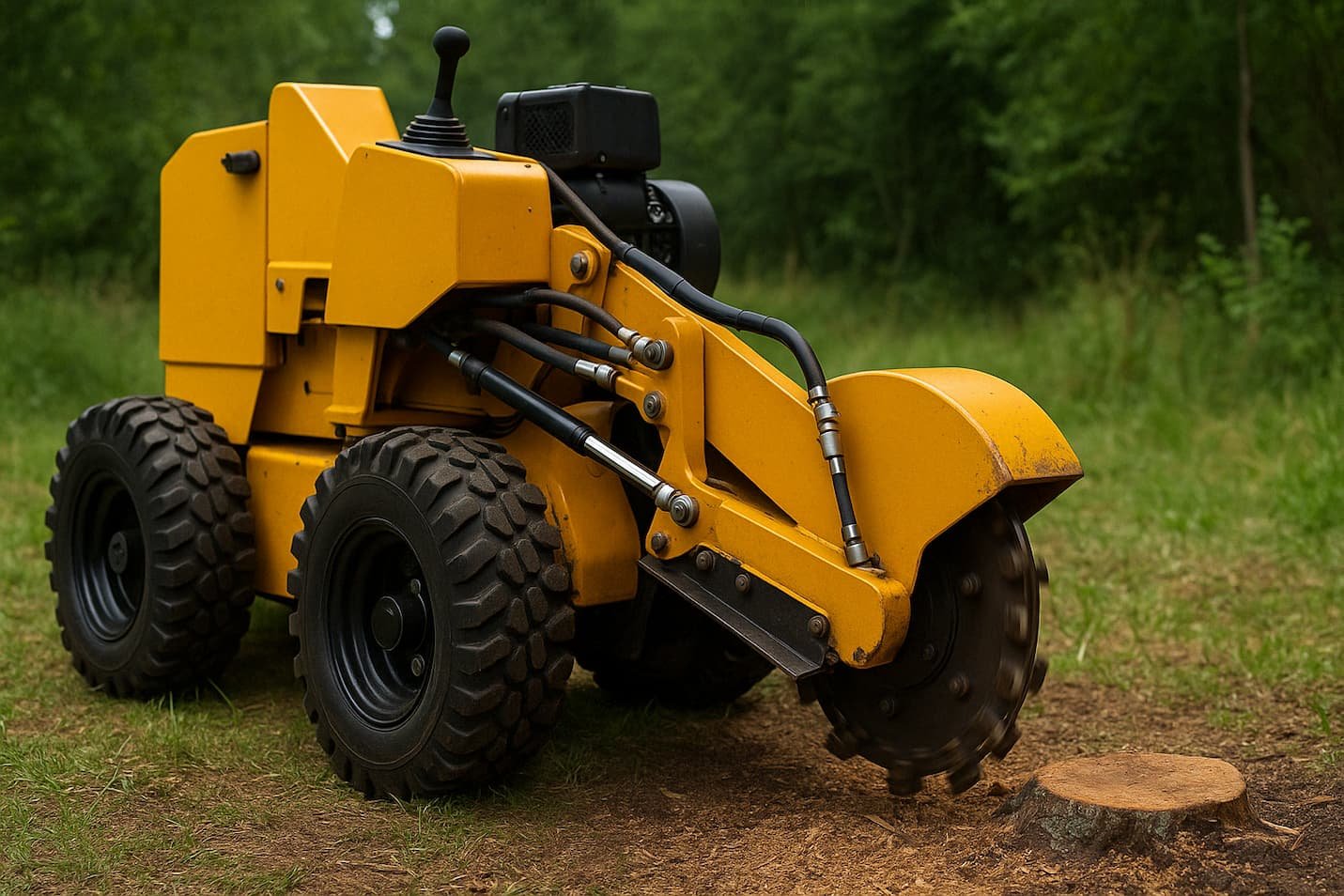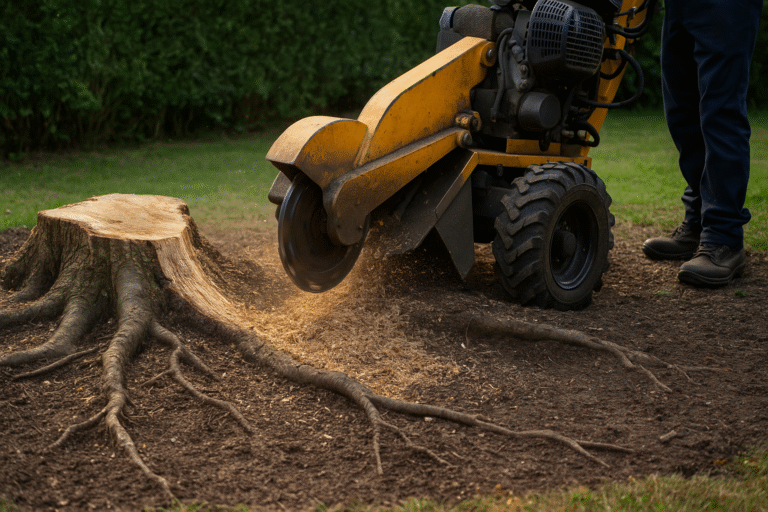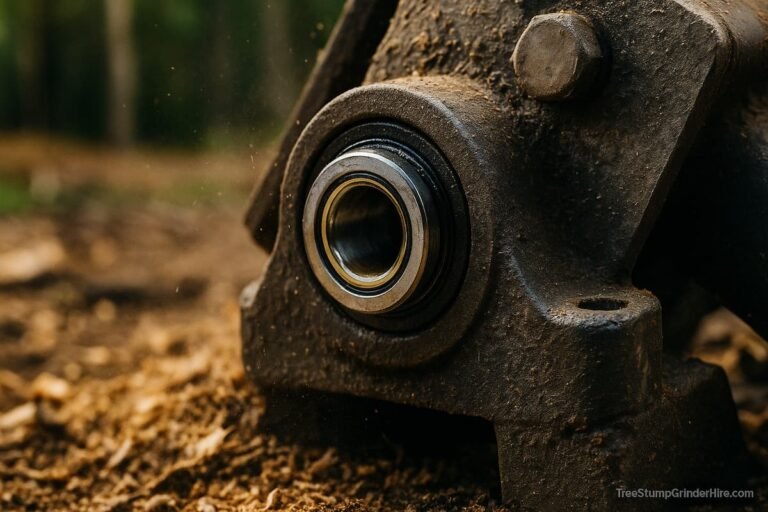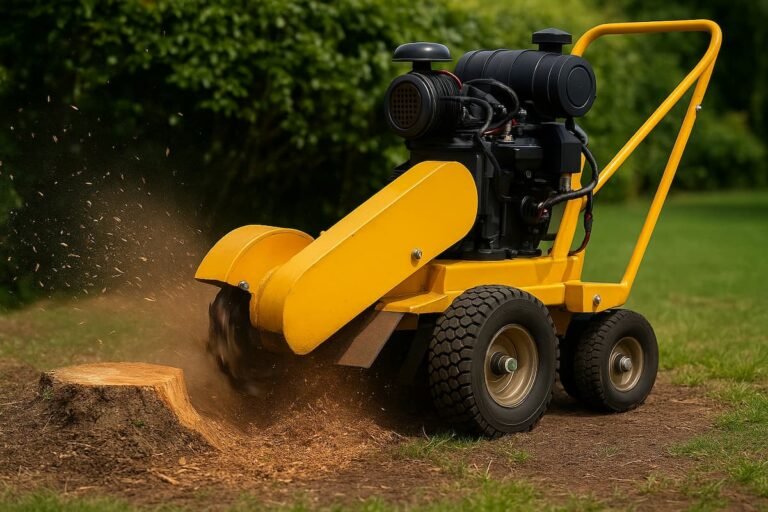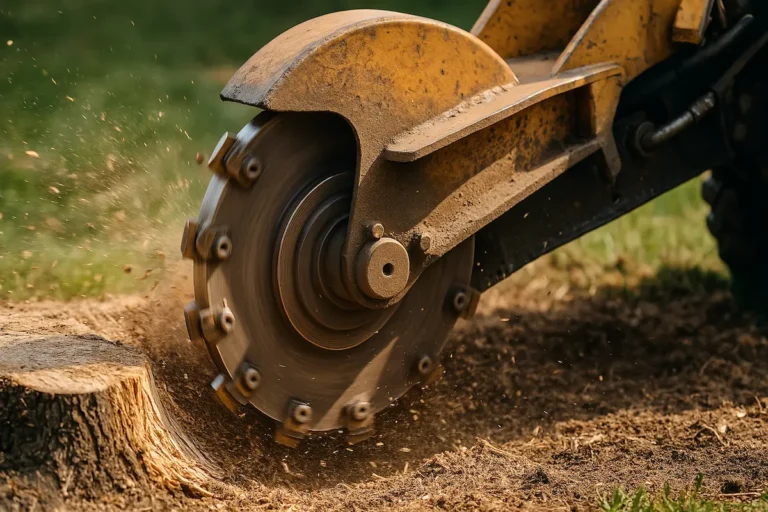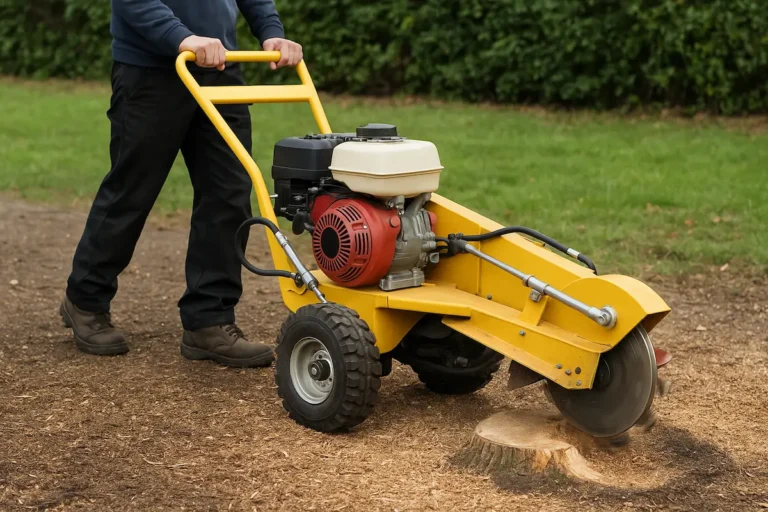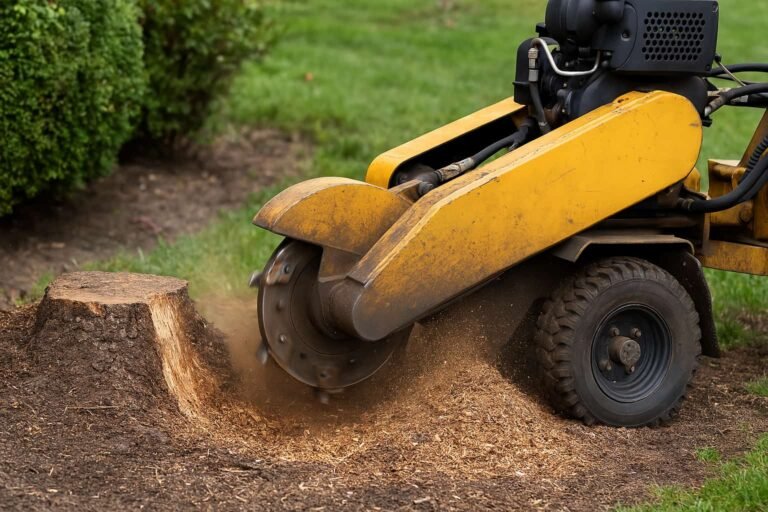Hydraulic Steering on Stump Grinders: Your Guide to Easier Grinding Hire
Hydraulic Steering makes big stump grinders easy to turn.
It uses extraordinary oil power, not just your muscles.
This guide explains how it helps when you hire a grinder.
What is Hydraulic Steering on a Stump Grinder?
Hydraulic Steering helps you steer a heavy stump grinder easily.
It’s mostly found on bigger, wheeled machines that drive themselves.
Think of it like power steering in a car but for a grinder.
This system uses hydraulic power instead of handlebars or levers you push hard.
Hydraulic means it uses pressurised fluid, like a special oil.
This power does most of the heavy work of turning the wheels.
So, you don’t need lots of strength to point the machine where you want it to go.
It makes moving the grinder around much, much simpler.
This differs from smaller grinders you push or tracked grinders that steer differently.
Hydraulic Steering is mainly for self-propelled wheeled grinders.
Key Takeaways: Hydraulic vs. Manual Steering
- Significantly Easier Operation: The chart highlights that hydraulic steering drastically reduces physical effort and makes turning the grinder much easier compared to manual steering.
- Superior Control & Precision: Hydraulic systems offer smoother, more precise control, crucial for positioning the grinder accurately, especially in tight spaces or on slopes.
- Better for Large Machines & Jobs: Hydraulic steering makes handling heavier, more powerful grinders feasible for more users and is highly beneficial for jobs involving multiple stumps or difficult terrain.
- Faster Repositioning: While not affecting grinding speed directly, the ease of movement allows for quicker repositioning between stumps, potentially speeding up the overall job.
- Trade-offs: Manual steering is simpler mechanically and typically found on smaller or lower-cost machines, but demands significantly more physical work from the operator.
Key Advantages: Why Hire a Grinder with Hydraulic Steering?
Hiring a stump grinder with hydraulic Steering offers many good things.
It makes the job feel less like hard work.
Here are the main reasons it’s a great feature:
Move Around Tight Spaces with Ease
Grinders with hydraulic Steering are much easier to turn.
Imagine trying to get a big machine through a garden gate.
Or maybe you need to steer around flowerbeds or paths.
Hydraulic Steering lets you make sharp turns without a big struggle.
You can position the grinder exactly where you need it over the stump.
This is super helpful in back gardens with lots of obstacles.
One user said,
“Turning my old manual steer grinder felt like wrestling a bear. The hydraulic steer one glides around corners!”
This easy movement saves you time and frustration.
You spend less effort fighting the machine and more time grinding.
Benefit: Great for gardens with tricky access or many things to steer around.
Reduce Physical Strain and Operator Fatigue
Steering a heavy machine using pure muscle power is tiring.
This is especially true on soft grass or bumpy ground.
Hydraulic Steering takes away almost all that effort.
The hydraulic system does the hard pushing and pulling for you.
You use a light touch on a lever or joystick.
This means you won’t feel as tired after using the grinder.
If you have many stumps to grind, this makes a huge difference.
You can work longer without getting worn out.
“My arms and back used to ache after a big job,” mentioned one operator. “With hydraulic steer, I feel fine at the end of the day.”
Less tiredness also means you can stay more focused and work safely.
Benefit: It makes grinding less tiring, especially for big jobs or multiple stumps.
Gain Superior Control and Precision
Hydraulic systems allow for very smooth and controlled turning.
Manual Steering can sometimes be jerky or stiff and difficult to manage precisely.
This is important when you are on a slope or uneven ground.
You don’t want the machine lurching unexpectedly.
Hydraulic Steering gives you fine control over the machine’s direction.
This helps you line up the grinder perfectly over the stump.
Precise positioning means you grind the stump effectively the first time.
It also helps avoid bumping into fences, walls, or garden ornaments.
A video review praised a grinder’s hydraulic Steering for letting the operator move across a neat lawn without causing damage.
Benefit: Offers smoother movement and helps position the grinder exactly right.
Potentially Increase Your Work Speed
Because the machine is easier to move, you can often work faster.
Less time spent struggling to turn means more time grinding.
Moving between stumps becomes quicker and takes less effort.
This adds up if you have many stumps spread across a property.
While it might not cut the grinding time, it cuts the positioning time.
Faster positioning leads to finishing the whole job sooner.
Think about moving from one side of a garden to the other.
With hydraulic Steering, it’s a quick drive. Manual Steering could be a sweaty workout.
Benefit: Faster repositioning between stumps can speed up the overall job.
Make Powerful Grinders Accessible to More Users
Some of the most potent and efficient stump grinders are large and heavy.
Without hydraulic Steering, these machines could be very hard for some people to handle.
Hydraulic Steering makes these big, productive machines usable by almost anyone.
You don’t need to be incredibly strong to operate them effectively.
This means you can hire a more powerful grinder to do the job faster without worrying about the steering effort.
It opens up bigger machines to homeowners or operators who might otherwise choose a smaller, less capable grinder.
Benefit: It allows more people to handle larger, faster grinders comfortably.
Summary of Why Hydraulic Steering is Great for Hirers:
- Easy Turning: Get into tight spots easily.
- Less Effort: Avoid getting tired quickly.
- Smooth Control: Position the machine perfectly.
- Quicker Moves: Finish the job potentially faster.
- Use Big Machines: Handle powerful grinders without needing enormous strength.
How Hydraulic Steering Works: A Simple Explanation
Understanding how it works helps you appreciate the benefits.
It’s like a team of helpers using oil power.
Here are the main parts and what they do:
- Engine Power: The grinder’s engine runs a hydraulic pump.
- The Pump: This pump pushes special hydraulic fluid (oil) under high pressure.
- Your Control: You use a lever, joystick, or sometimes a small wheel. This is your steering control.
- The Steering Valve: When you move the control, it tells a steering valve where to send the pressurised oil.
- Hydraulic Actuator: The oil flows through strong hoses to a hydraulic cylinder or motor connected to the wheels or axle.
- Turning Power: The oil pressure pushes the cylinder rod or turns the hydraulic motor.
- Wheels Turn: This force physically turns the grinder’s wheels left or right.
- Fluid Returns: Used oil flows back to a tank (reservoir) and is ready to be pumped again.
Think of it like this:
- You tell the system where to go (moving the lever).
- The pump provides the power (pressurised oil).
- The valve directs the power.
- The cylinder/motor does the heavy lifting (turning the wheels).
You only need to give the command with a light touch. The hydraulic system provides the muscle.
This system is strong and reliable when looked after properly.
Which Stump Grinders Typically Feature Hydraulic Steering?
You won’t find hydraulic Steering on every stump grinder.
It’s usually found on medium-to-large self-propelled wheeled grinders.
These are the machines that you drive rather than push.
Think grinders with engines around 35 horsepower (HP) or more.
Manufacturers like Bandit, Vermeer, Carlton, and Rayco often include it on their bigger wheeled models.
Examples of grinders often having hydraulic Steering:
- Bandit SG-40
- Bandit SG-75
- Vermeer SC382
- Vermeer SC40TX (Note: Tracked machines steer differently but can have hydraulic drive functions)
- Carlton SP series (some models)
What about other types?
- Small Push Grinders: These usually have simple handlebars. You push and pull them to steer them like a heavy lawnmower. There are no hydraulics for steering here.
- Tracked Grinders: Grinders with tracks instead of wheels steer differently. They usually use separate controls for each track (skid steering). One track moves faster or reverses to turn the machine. While hydraulics are used for the drive system, the steering method differs from wheeled hydraulic Steering.
So, if you hire a larger grinder with wheels that drives itself, it’s worth checking if it has hydraulic Steering.
Is Hydraulic Steering Right for Your Hired Grinder Job?
Deciding if you need this feature depends on your specific job.
Consider these points:
Assess Your Property’s Access and Terrain
How easy is it to get the grinder to the stumps?
- Tight Gates or Paths? Hydraulic Steering makes squeezing through narrow spots much easier.
- Lots of Obstacles? Flowerbeds, garden furniture, sheds? Easy Steering helps you move around them safely.
- Slopes or Hills? Hydraulic Steering gives better control on uneven ground where manual Steering can be difficult.
- Soft Ground? Trying to turn heavy wheels on soft grass requires manual effort. Hydraulics make it simple.
If your garden is complex or access is tricky, hydraulic Steering is a big help.
Consider the Number and Location of Stumps
How many stumps do you need to remove? Where are they?
- Multiple Stumps Far Apart? If you must drive the grinder across the garden many times, hydraulic Steering saves lots of effort and time.
- Just One Easy-to-Reach Stump? If the stump is near the access point on flat ground, the benefit might be less critical, although still nice to have.
- Very Large Stumps? Even on one stump, you might need to reposition the grinder slightly. Hydraulic Steering makes these minor adjustments easier.
For jobs involving several stumps or lots of repositioning, hydraulic Steering is highly recommended.
Match the Machine to Your Handling Confidence
How comfortable are you operating heavy machinery?
- First Time User? Hydraulic Steering makes larger, more powerful grinders feel less intimidating and easier to manage.
- Are you Concerned About Physical Strain? If you want to avoid heavy pushing and pulling, choose a machine with hydraulic Steering.
It provides a safety net of ease, making the physical task of steering almost disappear. This lets you focus on the grinding itself.
In short, If your job involves tricky access, multiple stumps, large areas, or slopes, or if you want the easiest possible experience, ask for a grinder with hydraulic Steering.
Are There Downsides? Factors to Consider
While hydraulic Steering is mainly beneficial, there are some points to remember.
Understanding the Added Complexity
Hydraulic systems have more parts than simple manual Steering.
There’s a pump, valves, hoses, cylinders, and fluid.
- More Parts: More components mean more things could leak or wear out over time.
- Maintenance: These systems need regular checks (fluid level, hose condition). This is the hire company’s job (treestumpgrinderhire.com maintains its machines well!), but it’s part of the machine’s makeup.
- Potential for Repairs: Occasionally, a hose might leak, or a component might fail. This is uncommon on well-kept hire machines but is possible with any hydraulic equipment.
Forum users sometimes discuss fixing hydraulic leaks, especially on older machines. This highlights that maintenance is essential.
Point to Note: Added parts mean slightly more potential for issues, but reliability is generally excellent on maintained equipment.
How It Affects Hire and Purchase Costs
Making a grinder with hydraulic steering costs more for the manufacturer.
These machines have extra components and engineering.
- Higher Purchase Price: Grinders with hydraulic Steering are generally more expensive to buy initially.
- Potentially Higher Hire Rate: Because the machines cost more to own and maintain, the hire price might be slightly higher than for a similar-sized grinder with basic manual Steering.
However, many users feel the extra cost is worth it for the reduction in effort and improved usability.
Think of it as paying more for a much easier and potentially faster job.
Point to Note: Expect machines with this feature to sometimes cost a little more to hire, but the benefits often outweigh the extra cost.
See it in Action: Real-World Grinding Scenarios.
Let’s look at how hydraulic Steering helps in typical jobs:
Tackling Suburban Garden Stumps Efficiently
Imagine Mrs. Jones wants three medium-sized stumps removed from her back garden.
Access is through a narrow side gate (90cm wide).
The garden has prize-winning flowerbeds and a winding path.
The stumps are near the back fence, behind a rose bush.
Without Hydraulic Steering: Getting a large manual steer grinder through the gate would be tough. Turning it on the path without damaging the lawn edges would require significant effort. Manoeuvring around the flowerbeds and positioning near the fence would be slow and physically demanding, and the operator might tire.
Hydraulic Steering allows the operator to easily guide the grinder through the gate using the light joystick control. Smooth turns allow careful movement along the path, and the grinder easily steers around the flowerbeds. Precise control lets the operator position the cutting wheel perfectly over each stump, even the awkward one behind the rose bush. The job is done faster, with less sweat, and no damage to Mrs. Jones’s lovely garden.
Making Large Clearing Projects More Manageable
A landscaper must clear 30 large tree stumps from a field turned into a sports pitch.
The ground is uneven in places.
Without Hydraulic Steering, Wrestling a heavy manual steer grinder across the uneven field 30 times would be exhausting. Turning the machine constantly to position it on each stump would take significant time and physical energy. Operator fatigue could slow down the project and increase the risk of mistakes.
With Hydraulic Steering, The operator drives the grinder smoothly between stumps, even over rough patches. Quick, effortless turns allow rapid positioning on each stump. The reduced effort means the operator stays fresh and productive throughout the day. The entire project is completed much faster and more comfortably.
These examples show how hydraulic Steering transforms the usability of larger grinders in real situations.
What Operators Say: User Experiences with Hydraulic Steering
Hearing from people who use these machines is valuable. Here’s a summary of common feedback found online (forums, video comments):
- “Game Changer”: Many operators describe upgrading to a hydraulic steer grinder as a ‘game changer’ for ease of use.
- “Smoothness”: Users frequently praise how smooth and effortless the Steering feels compared to fighting manual controls. “The hydraulic Steering on this Bandit is incredibly smooth. Makes getting around the job site a breeze.”
- “Less Fatigue”: A common comment is feeling less tired. “If you’re doing multiple stumps a day, trust me, get the hydraulic Steering. Your back and arms will thank you.”
- “Worth the Cost”: Even acknowledging the higher price, most users feel the benefit justifies the expense or slightly higher hire rate.
- “Essential for Big Machines”: For larger grinders (like 40HP+), many consider it an essential feature, not just a luxury. “Wouldn’t go back to manual steer for this size machine.”
- “Good for Tricky Spots”: People often mention how it helps in tight residential gardens. “Was hesitant about the size, but the hydraulic steering makes this big grinder surprisingly easy to handle, even in tight spots.”
- Hire Shop Perspective: Sometimes, hire company owners comment, too. “When hiring out our bigger grinders, the ones with hydraulic steering are always more popular, especially for customers who haven’t used one before.”
Overall Sentiment: Users overwhelmingly view hydraulic Steering on wheeled stump grinders positively, highlighting ease of use and reduced physical effort as the main benefits.
Hydraulic vs. Manual Steering: Quick Comparison
Here’s a simple table summarising the key differences:
| Feature | Hydraulic Steering | Manual Steering |
|---|---|---|
| How it Works | Uses pressurised oil power | Uses operator muscle via levers/bars |
| Steering Effort | Very Low | High (especially on heavy machines) |
| Manoeuvrability | Excellent, easy tight turns | Can be difficult, requires space |
| Control | Smooth & Precise | Can be jerky, harder to position |
| Operator Fatigue | Significantly Reduced | Can be very tiring |
| Speed | Faster positioning between stumps | Slower positioning |
| Machine Size | Common on Medium/Large Wheeled | Common on Smaller & Push Grinders |
| Complexity | Higher (pump, hoses, valves) | Lower (simpler mechanics) |
| Cost | Higher purchase/hire price | Lower purchase/hire price |
| Best For | Tricky access, multiple stumps, slopes | Simple jobs, tight budgets, small machines |
This table helps you see the main trade-offs at a glance. The benefits of hydraulic Steering are clear for most hire situations involving larger wheeled grinders.
Common Problems Summary (And What We Do)
While hydraulic Steering is reliable, like any system, issues can occur over long periods of heavy use. Here’s what to be aware of (and why hiring from us is safe):
- Oil Leaks: Hoses or seals can sometimes develop leaks.
- Our Check: We regularly inspect hoses and connections for wear or damage before each hire.
- Your Action: If you see oil drips during your hire, stop using the machine and call us immediately.
- Weak/Slow Steering: This could indicate low fluid or a pump issue.
- Our Check: We check hydraulic fluid levels and system performance as part of our maintenance.
- Your Action: If Steering feels unusual or weak, contact us immediately.
- Hose Damage: Hoses can get snagged or damaged if the machine is used carelessly around sharp objects.
- Our Check: We ensure hoses are routed safely and check for damage.
- Your Action: Be mindful of the hoses near debris or obstacles.
Your Peace of Mind: At treestumpgrinderhire.com, we carefully maintain our machines, including all hydraulic systems. We perform regular checks and preventative maintenance to ensure everything works correctly and safely for your hire period. If a problem does occur, we provide prompt support.
Basic Checks: Looking After Hydraulic Steering on a Hired Machine
When you hire a grinder from us, we ensure it’s in top condition.
However, there are a couple of simple things you can do during use:
- Look for Leaks: Before starting, and occasionally during use, glance at the hydraulic hoses and connections. Stop and call us if you see any obvious oil drips or wet patches. Don’t try to fix it yourself.
- Listen for Strange Noises: If the Steering starts making unusual whining or grinding sounds, it could signal an issue. If it stops working, please let us know.
- Check Steering Feel: If the Steering suddenly feels very stiff, very loose, or jerky, it’s best to stop and report it.
- Keep Hoses Clear: Be aware of where the hydraulic hoses run. Avoid letting them get caught on branches or run over sharp objects.
Main Point: Our machines are checked and ready to go. Your main job is immediately reporting any unusual behaviour (leaks, noises, odd feelings) to us. This ensures safety and prevents potential damage.
Why Hydraulic Steering Matters for Your Stump Grinder Hire Choice
Understanding hydraulic Steering helps you pick the best machine from treestumpgrinderhire.com.
It’s a key feature that makes a real difference.
We Offer Hydraulically Steered Grinders for Demanding Jobs
We know that many stump-grinding jobs can be challenging work.
Our hire fleet includes powerful wheeled grinders equipped with hydraulic Steering.
We invest in these machines because they offer you the following:
- More effortless Operation: This is especially important if you’re not a professional tree surgeon.
- Less Physical Work: Makes the job more comfortable and achievable.
- Better Access: Helps you get the grinder into position even in awkward gardens.
- Increased Efficiency: This potentially allows you to finish your project faster.
When you browse our grinder options, look for “Hydraulic Steering” listed in the features.
Get Advice: Choosing the Best Grinder for Your Needs
Do you need hydraulic Steering?
Which size grinder is right for your stumps and property?
Just ask us!
Our friendly team knows our machines inside out.
We can discuss your specific job:
- How many stumps? How big are they?
- What’s the access like? (Gates, slopes, obstacles)
- Your experience level with machinery.
Based on this, we can recommend the best stump grinder hire option.
We want you to have a successful and stress-free hire experience. Choosing the right machine with hydraulic Steering is a big part of the process.
Conclusion: Hire Smarter with Hydraulic Steering Knowledge
Hydraulic Steering is a fantastic feature on medium-to-large wheeled stump grinders.
It makes steering almost effortless, helping you move the machine easily around obstacles and position it accurately.
This means less physical strain, potentially faster work, and the ability for more people to handle powerful grinders.
While these machines might cost slightly more to hire, ease of use and comfort often make them worthwhile, especially for tricky access or multiple stumps.
Your Next Steps:
- Assess your job: Think about your garden access, terrain, and number of stumps.
- Consider the benefits: Decide if easier Steering and less effort are essential for you.
- Browse our hire options: Look for grinders listed with Hydraulic Steering.
- Contact Us: If unsure, call or message us for expert advice on the best grinder for your project.
Ready to make your stump grinding job easier?
Check out our range of easy-to-steer stump grinders available for hire today!

